Shilluk …Folklore Tells Their History and Legendary

Sudan Events
Shilluk are the third-largest ethnic group of South Sudan, followed Dinka and Nuer.
Shilluk, like the other Nilotic-speaking peoples of southern Sudan, have a system of relationship terminology that is commonly known as “descriptive.”
Legal marital unions are established by the exchange of bride-wealth cattle, which pass from the agnatic kin of the groom to the adult members of the bride’s family.
A man is commonly 25 years old before his first marriage, whereas it is customary for a young woman marry before she reaches the end of her teen years.
A wedding feast in the bride’s father’s homestead follows the exchange of bride-wealth cattle.
At the end of these festivities, the bride and groom return to establish their own homestead in the hamlet of the groom’s father.
It is reported that a mock battle is enacted between the groom’s and the bride’s kin, once the last of the promised bride-wealth cattle are given.
The ideal number of bride-wealth cattle should amount to at least ten animals, including cows, oxen, and a bull.
Addition to the bride’s family expects to receive diek nom, a number of sheep, as well as jam nom, gifts of spears and other goods.
The latter gifts belong to the parents of the bride, but the sheep are distributed among the bride’s agnatic kin.
When a wife is pregnant for the first time, it is customary for her to return to her natal village to give birth.



